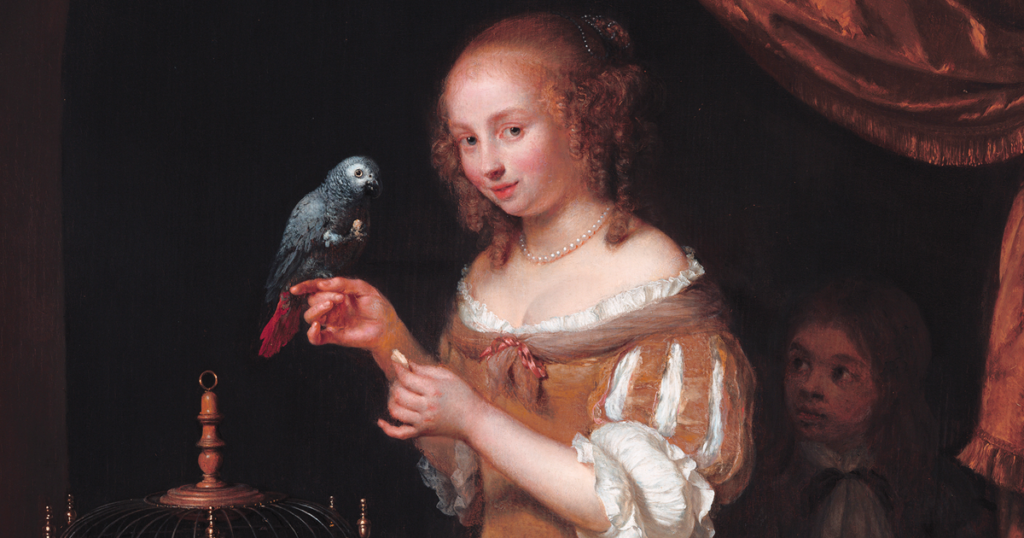Going Dutch
In these relentlessly disruptive times, 17th-century canvases from the Netherlands can provide moments of solace and hope

I was standing in a room at the National Gallery of Art last October, puzzling at three Dutch paintings of women with parrots: Gerrit Dou’s Woman With a Parrot (1660), Frans van Mieris’s Woman Feeding a Parrot (1663), and Caspar Netscher’s Woman Feeding a Parrot, With a Page (1666). Having come to see the 65 works making up Vermeer and the Masters of Genre Painting: Inspiration and Rivalry, I had already looked at three paintings of women with lutes; two of women with clavichords; a half dozen of women writing, reading, or sealing letters (as well as one of a man writing a letter); two of women weighing coins on a balance scale; three of women washing their hands; and two of women peeling produce—an apple in one case, a parsnip in the other. Yet the parrots gave me pause. Why, I wondered, had three of the most famous Dutch genre painters dealt with the same scene within six years of one another? The accompanying wall text provided little help: “Expensive pets imported from the distant lands of the vast Dutch commercial empire, parrots were valued for the beauty of their plumage and their ability to imitate speech.”
I’m a total geek for Dutch genre painting, and I adore the lesser-known Dutch genre painters such as Dou, Pieter de Hooch, Gerard ter Borch, and Nicolaes Maes. Yet the exhibit left too many questions unanswered. In one room, Maes’s Woman Scraping Parsnips, With a Child, ter Borch’s Woman Peeling Apples, and de Hooch’s Woman Nursing an Infant, With a Child and a Dog shared a wall. Why the apparent obsession with those particular domestic tasks? Why did Maes choose the humble parsnip, with ter Borch opting for the more luxurious apple? We can intuit something about social class based on these depictions, but exactly what? Most important, why, more than 300 years later, do these paintings, these variations on similar themes, still fascinate us?
Vermeer and the Masters of Genre Painting had originally seemed too quiet a response to our cultural moment. To me, it felt more appropriate to look at overwhelming, important, and disruptive paintings, such as Picasso’s Guernica or Goya’s The Third of May 1808, or Munch’s The Scream. But perhaps now is precisely the moment to spend quality time with Gabriel Metsu’s Man Visiting a Woman Washing Her Hands or Maes’s Young Woman Making Lace or Dou’s Astronomer by Candlelight.
A decade ago, the English writer Alain de Botton observed, “There’s something deeply embarrassing about loving the Dutch 17th century painter Pieter de Hooch deeply, so deeply that one would include him among one’s favorite painters of all time.” De Botton admitted that many of de Hooch’s works are “plain mediocre,” that he is operating “in a minor genre,” and that “his pictures are too pretty and yet not quite pretty enough.” Nevertheless, the Dutch genre painters like de Hooch can help us quietly recover our balance. “His works,” de Botton noted, “perform the valuable task of reminding us of the interest and worth of modest surroundings, quelling vain ambitions and temptations to disengage snobbishly from ordinary routines: the evening meal, the housework, a drink with friends.”
It’s important to remember that looming in the background of these tranquil domestic scenes were tumultuous historical events, including the Thirty Years and Eighty Years wars, which set the Netherlands aflame in the 17th century. Between 1652 and 1674, England and the Provinces of the Netherlands went to war three times, and in the end the Dutch lost New Amsterdam (New York) to the English. These events followed years of terrible religious conflict—the Reformation and the Counter Reformation. And yet, to look at a quiet painting like Dou’s A Young Lady Playing a Clavichord, one might never know about the outside world. In that way, these paintings are examples of radical art—radically rejecting kings and generals, battles, or grand biblical scenes as their subjects. History, they suggest, happens not only on the battlefield or in government offices, but also in the kitchen or the sitting room or at a window overlooking a quiet middle-class street.
Perhaps these works, with their serenity, are exactly the kind of disruption we need, offering a moment of calm away from the 24-hour news cycle and Twitter. There is an odd reassurance, both visual and emotional, to be found in de Hooch’s Woman Weighing Coins or the three renditions of Lady at Her Toilet, one each by ter Borch, Dou, and Netscher. There is stillness, and a reminder that someday life can and will return to that kind of stillness.

